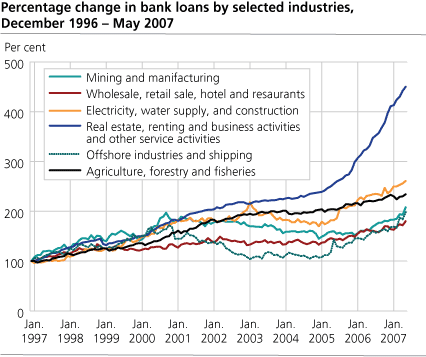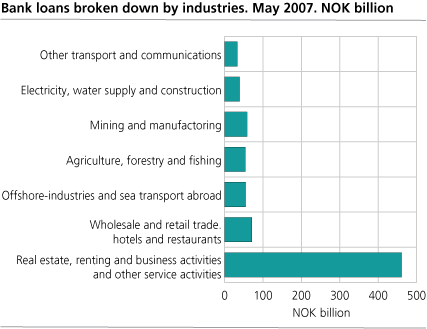Content
Published:
This is an archived release.
Sharp increase in loans to real estate business
The course of bank loan development varies a lot between different industries. In the last couple of years loans to real estate industries have grown rapidly. In comparison, loans to primary industries developed more moderately within the same time period.
Bank loans to business activities, real estate and financial industries, including other service industries, reached NOK 460.6 billion at end-May. As shown in the monthly statistics of banks balance sheets, this amount has doubled more than four times since 1996.
The annual statistics for banks show that business activities and real estate business are the largest borrowing industry, accounting for 56 per cent of total bank loans to industries at the end of 2006. Of this, loans to real estate business accounted for 77 per cent. This increase is related to the high activity in the real estate market and the strong growth in housing prices in the last couple of years.
Moderate development in primary industries
Loans to agriculture, forestry and fisheries (primary industries) reached NOK 54.4 billion at end-May. The annual statistics shows that loans to agriculture and forestry accounted for 51 per cent of total bank loans to the primary industries at the end of 2006. In comparison, loans to fisheries and hunting were 29 per cent, and 20 per cent to aquaculture-related activities.
Loans to the agricultural industry has doubled over the last 10 years, and at the same time there has been a large reduction in the number of producing units. This indicates that the amount of debt per unit has increased considerably, and has been a substantial increase in efficiency in the agricultural sector in the same period. The income of the industry has increased from NOK 6.5 billion in 1999 to NOK 7.4 billion in 2005 (Farmers' income and property)
Loans to off-shore industries grows rapidly
Loans to the off-shore industry only accounted for 7 per cent of banks total industry loans at end-May. However, loans to this industry have grown rapidly in the last couple of years. This growth rate also varies a lot due to the fact that the oil companies mainly get their financing abroad.
The C3 statistics shows that oil and shipping industries had total external loan debt reaching NOK 328 billion at the end of March, of which NOK 269 billion (82 per cent) was financed abroad.
Other industries
Since 1996 bank loans to the (mainland) power and building industry has almost tripled. Details in the annual statistics shows that power and water industry accounted for about one-third, and the building industry accounted for the remaining two-thirds. During the same period of time bank loans to mining and manufacturing, wholesale and retail trade and to the hotels/restaurant sector were doubled.
|
In this article we have focused on bank loans (excluding loss provisions) to all institutional sectors between sector 610 and 790, including sector 890, which are the sectors split in different industries. In the monthly balance sheets (report 10/50) aggregated industry codes are being used, while the annual statistics (report 60) uses a set of more detailed industry codes. |
The statistics is now published as Banks and mortgage companies.
Contact
-
Statistics Norway's Information Centre
E-mail: informasjon@ssb.no
tel.: (+47) 21 09 46 42


